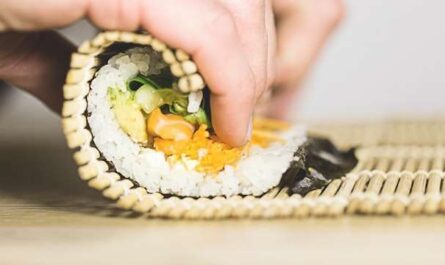For those who find joy in the heart-warming art of sushi-making, understanding the sushi preparation workflow is imperative. In our journey today, we will explore the delicate craft of transforming fresh ingredients into a delectable masterpiece. Lets dive into a journey that enhances our culinary abilities and appreciation for this beloved Japanese cuisine.
Sushi has a history rich with tradition, transforming humble ingredients into art on a plate. The sushi preparation workflow involves particular steps, all finely tuned for best results. Whether you craft rolls at home or dream of becoming a sushi chef, this workflow aims to elevate your understanding and skills.

Understanding Sushi Craft
Grasping the art of sushi is crucial before delving into the preparation steps. Sushi refers to vinegared rice combined with various ingredients such as raw fish, vegetables, and seaweed. This art focuses on fresh, high-grade ingredients, ensuring the end dish is a true testament to Japanese culinary beliefs.
Types of Sushi
Before the preparation begins, identifying the varied styles of sushi is helpful:
- Nigiri – A form where sliced fish rests atop seasoned rice.
- Maki – A traditional rolled sushi encased in seaweed.
- Temaki – Known as hand rolls, these are cone-shaped and easier to prepare.
- Sashimi – This is not technically sushi as it lacks rice, featuring fresh fish slices alone.
- Uramaki – Known for the rice being on the outside.
Each form offers a distinct taste and presentation, holding its unique spot in the sushi realm.
Embarking on the Sushi Journey
Selection of Ingredients
The first step is selecting the freshest ingredients. Quality matters greatly in maintaining authenticity and traditional essence. Look for sushi-grade fish as they assure safety when consumed raw, and embrace seasonal produce for added flavor and sustainability.
Preparing the Sushi Rice
The foundation of any sushi is the rice. Perfecting sushi rice involves rinsing the grains meticulously to remove excess starch. This ensures that the final product is not sticky but remain fluffy. Follow through with cooking the rice, then mix in a vinegar, sugar, and salt blend for flavor.
Using a wooden Hangiri bowl may provide a traditional touch and improve the rice flavor.
Cuts that Matter
Precision in cutting fish and vegetables cannot be emphasized enough. Mastery of using a sharp Japanese knife like a Yanagiba is essential to achieve clean slices that do not obliterate the natural flavors.
Art of Assembly
Using Seaweed Wisely – Rolling Maki
Seaweed or Nori is a flexible yet crucial ingredient in sushi. When preparing Maki, lay the Nori sheet on a bamboo mat, followed by an even spread of rice. The fillings align centrally, paving the way for a gentle roll using a bamboo mat for aid.
Nigiri Craftsmanship
Performing the simple yet skillful act of forming small rice balls is an essence of Nigiri. With practice, shaping rice with a light, serif hand pairs beautifully with a piece of fresh fish atop, creating this beloved sushi type.
Hand Way Using Temaki
For a more hands-on approach, Temaki provides flexibility. Shape rice and fillings in a cone form using your hands. Its unique for intimate serving and is a crowd-pleaser when hosting gatherings.
Essential Equipment in Sushi Making
Having the right tools can ensure you streamline the sushi preparation workflow efficiently:
- Japanese Chef Knives – crucial for precision slicing.
- Bamboo Mats – essential for rolling sushi.
- Hangiri – for seasoning and cooling rice effectively
Presentation – A Visual Delight
Never underestimate the impact of presentation in sushi making. A beautifully laid plate enhances the dining experience and respects the time-honored tradition of this Japanese cuisine.
Color Symmetry
Choose ingredients wisely, creating a visual feast filled with color harmony. Striking the right balance not only entices taste buds but also elevates the aesthetic value.
Garnishing Touch
Adding garnishes like pickled ginger and wasabi alongside sliced sushi flavors each bite, acting as vital accompaniments to the sushi dish.
Consider Etiquette and Serving
Understanding sushi etiquette enhances the whole experience, respecting traditions that have been honed over centuries. You can learn more about sushi etiquette here. Additionally, serving sushi with authentic Japanese soy sauce and aesthetically arranged chopsticks complements your sushi endeavor.
Sushi and Soy Sauce
Immerse sushi pieces lightly in soy sauce, emphasizing the flavor rather than overpowering it. It is a subtle element that contributes significantly to the authentic taste.
Appreciating Every Bite
Unlike fast-food culture, savor each bite. Sushi is about enjoying the complex flavors merging slowly, creating a memorable culinary journey in every mouthful.

Frequently Asked Questions
What is the first step in the sushi preparation workflow?
The initial step is selecting the freshest ingredients, focusing on high-quality fish and seasonal ingredients.
Why is precision important in sushi preparation?
Precision ensures each sushi piece maintains its structure and incorporates flavors harmoniously.
How do you serve sushi correctly?
Sushi is served with condiments like pickled ginger and wasabi, alongside a delicate serving of soy sauce, respecting centuries-old etiquette.
With this comprehensive guide on the sushi preparation workflow, you can appreciate and craft sushi with enhanced knowledge and skills, truly immersing yourself in the artistry and tradition that sushi making embodies. Happy rolling!
This article contains affiliate links. We may earn a commission at no extra cost to you.



